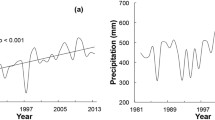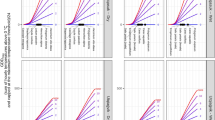Summary
Winter minimum temperatures were recorded at four sites in Station Cove, a forested flat-bottomed ravine in the southern Appalachians of South Carolina, U.S.A. Unlike minimum temperatures found in frost hollows, cove minima were warmer than those found outside of the cove. Within the cove, minimum temperatures at study sites in the narrow, gorge-like western portion near a 20 m high cascade were warmer than those in the broader, eastern portion. Additionally, minimum temperatures near the ground were warmer than those at 1.4 m height above the surface. Selected spring-flowering plant species bloomed earlier in the western portion of the cove, while for the same plant species, within cove flowering dates were 2 to 3 weeks earlier than those outside of the cove. Station Cove, therefore, appears to harbor a microclimate that allows for much earlier flowering and leafing out of plant species in spring than does the surrounding region.
Zusammenfassung
Winter-Minimumtemperaturen wurden an vier Meßstellen in Station Cove, einer bewaldeten Schlucht mit flachem Boden in den südlichen Appalachen von South Carolina, U.S.A., registriert. Im Gegensatz zu den Minimumtemperaturen, die in Frostlöchern auftreten, waren die Talschluchtminima wärmer als die außerhalb der Schlucht gemessenen. Innerhalb des Tales waren die Minimumtemperaturen im schluchtartigen, westlichen Ende in der Nähe eines 20 m hohen Wasserfalls wärmer als die im breiteren, östlichen Teil des Tales. Außerdem waren die Minimumtemperaturen in Bodennähe wärmer als die in 1,4 m Höhe gemessenen. Einige Arten von Frühlingsblumen blühten im westlichen Teil der Talschlucht früher als im östlichen Teil. Dieselben Arten blühten in der Schlucht 2 bis 3 Wochen früher als außerhalb der Schlucht. Station Cove ist daher durch ein Mikroklima charakterisiert, das im Vergleich zum umliegenden Terrain ein früheres Austreiben und Blühen der Pflanzen im Frühling erlaubt.
Similar content being viewed by others
References
Baum, W. A.: On the Relation Between Mean Temperature and Height in the Layer of Air Near the Ground. Ecology30, 104–107 (1949).
Billings, W. D., Anderson, L. E.: Some Microclimatic Characteristics of Habitats of Endemic and Disjunct Bryophytes in the Southern Blue Ridge. The Bryologist69, 76–95 (1966).
Braun, E. L.: Deciduous Forests of Eastern North America, 596 pp. Philadelphia: Blakiston 1950.
Cazeau, C. J., Brown, C. Q.: Guide to the Geology of Pickens and Oconee Counties, South Carolina. Geologic Notes (South Carolina State Division Geology)7, 31–40 (1963).
Gates, D. M.: Energy Exchange in the Biosphere, 151 pp. New York: Harper and Row 1962.
Geiger, R.: The Climate Near the Ground, 611 pp. Cambridge, Mass.: Harvard University Press 1966.
Gettman, R. W.: A Floristic Survey of Sumter National Forest — Andrew Pickens Division. M.S. Thesis, Clemson University, 131 pp. South Carolina: Clemson 1974.
Lee, R.: Forest Microclimatology, 276 pp. New York: Columbia University Press 1978.
Nunez, M., Oke, T. R.: Long-Wave Radiative Flux Divergence and Nocturnal Cooling of the Urban Atmosphere II: Within an Urban Canyon. Boundary-Layer Met.10, 121–135 (1976).
Oke, T. R., Maxwell, G. B.: Urban Heat Island Dynamics in Montreal and Vancouver. Atmos. Environm.9, 191–200 (1975).
Taylor, F.: Phenodynamics of Production in a Mesic Deciduous Forest. In: Ecological Studies, Vol. 8, Phenology and Seasonality Modeling (Lieth, H., ed.), pp. 237–254. Berlin-Heidelberg-New York: Springer 1974.
Wolfe, J. N., Wareham, R. T., Scofield, H. T.: The Microclimates of a Small Valley in Central Ohio. Trans. Amer. Geophys. Union24, 154–166 (1943).
Author information
Authors and Affiliations
Additional information
With 1 Figure
Rights and permissions
About this article
Cite this article
Gaddy, L.L., Suckling, P.W. & Meentemeyer, V. The relationship between winter minimum temperatures and spring phenology in a Southern Appalachian Cove. Arch. Met. Geoph. Biocl., Ser. B 34, 155–162 (1984). https://doi.org/10.1007/BF02275681
Received:
Issue Date:
DOI: https://doi.org/10.1007/BF02275681




